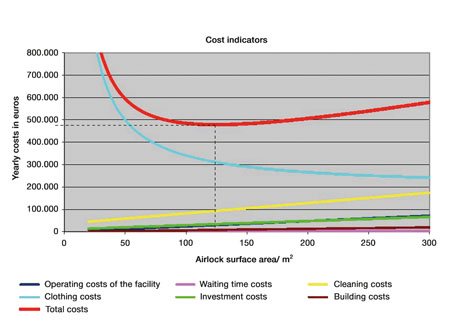When building a cleanroom, getting the entry airlock right is important. Florian Dittel, Dittel Engineering, looks at why, when designing airlocks, smaller can often turn out to be more expensive.
The airlock system that allows personnel to pass through from a non-controlled environment into a cleanroom is for many cleanroom operators an unwelcome cost. While the cleanroom itself provides a measurable economic benefit, the airlock seemingly only provides access to the controlled area and requires maintenance, while not obviously adding to the bottom line profit. The common consequence is often the decision to make personnel airlocks as small as possible. This can, however, work out more expensive in the long run.
This point is well illustrated by Florian Dittel, chief technical officer of Dittel Engineering, in an academic paper that won him the Albert Tichelmann prize for Best Diploma from the German Association of Engineers – the VDI. In his thesis, Dittel developed a formula to calculate the optimal size of personnel airlocks for cleanrooms from an economic point of view.
“The idea is to minimise the footprint of airlocks as much as possible for reasons of cost. But to keep both the operating and capital costs of an airlock low, it is necessary to identify all the factors that may impact on operation and cost in the early stages of conceptual design, and then to evaluate and incorporate these into the planning,” says Dittel.
Although such an airlock is essential for many cleanrooms, and represents a significant cost factor, until now there has been no available mathematical model for their efficient design, construction and operation. Dittel has shown that the airlock size can have a decisive influence on cost-effective operation, and this can be calculated exactly.
For a calculation of costs relating to planning, construction and operation, the following points need to be considered:
- General building/rental costs
- Costs of the individual building trades involved
- Personnel expenditure
- Cleaning costs
- Maintenance costs
- HVAC system operating costs
More specific factors that have a cost relevance are:
- Industry sector use
- Purity class
- Amount of air supply required
- Consumables
- Number of personnel expected to use it
- Changing time
- Size and footprint
The single most important cost is that of the personnel, regardless of the size and type of lock. This item mainly determines the annual cost of operation and is, therefore, particularly important. The costs arise from the duration of undressing which, if protracted, can incur delays in production. Other factors that are dependent upon the number of users are the amount of cleanroom clothing required and the amount of consumables, as well as the expense of cleaning.
Actual examples can be used to illustrate the correlation between costs, staff numbers and size of the airlock. For example, according to Dittel, the ideal surface area of an airlock calculated for a business with 130 users and a Class 8 DIN EN ISO 14644-1 cleanroom is between 95 and 170m2.
Because the company in question was looking at running a two-shift operation, the busy periods in the changing rooms would mean increased personnel costs. If these factors are added into the calculation of the airlock size, the result for the most cost-effective size (in terms of both operating and investment costs) is 125m2.
The reason for this is that the larger airlock allows more people to move around. It accelerates the shift change and lessens the waiting time in the airlock, which reduces the delay in the production process, offers greater comfort for the employees, and ensures that there is enough flexibility for future growth.
False economies can also result from misdirected savings. For example, so-called “soft factors” – such as the training and convenience of personnel – can have an impact. Particulate and microbiological contamination is not visible to humans. Thus, employees often underestimate the risks of contamination caused by incorrect behaviour while in the airlock.
Training, and some concessions on clothing and room size can reduce long term costs, but, “if savings are made on training and comfort, the danger is that employees, will use the airlock incorrectly or more often than is necessary, e.g. for short breaks, and will thus increase the risk of contamination,” says Dittel.

How cost factors behave with an increase in floor area
Cleanroom airlocks – Principles of operation
The consistently low bioburden and air quality required in cleanrooms is threatened the most by personnel that visit, maintain and operate the facilities, as they are large carriers of particles.
Airlock systems in conjunction with the air conditioning systems are, therefore, a key element in cleanroom technology.
The airlock prevents the ingress of particulate and microbiological contamination while enabling:
- entry into a higher purity level, without affecting the process that is running
- the insertion and removal of objects
- the storage and supply of cleanroom clothing
The various operating principles of airlocks include: low-turbulence displacement flow (laminar flow), turbulent displacement flow and directional flow. Their use is dependent on the purpose and purity class required.
There are three different approaches that can be used in cleanroom facilities to delineate pure and less pure areas. These are:
- the displacement approach of using directed air currents to provide a clear separation between clean and unclean areas
- the differential approach of controlling the air pressure to direct the flow of air
- the barrier concept, which uses airtight boundaries such as walls to separate areas
Regardless of the chosen operating principle, the personnel airlock always provides a buffer zone between two regions of different cleanliness levels and stress levels – e.g. between the cleanroom and outdoor area or a class B and class C facility.
In the airlock itself, generally on the “clean” side, the air is filtered through HEPA filters and is sucked away on the “dirty” side at floor level. Thus it prevents unwanted contamination from the outside travelling into the cleanroom.




